DeWalt DCL050 Handleiding
Bekijk gratis de handleiding van DeWalt DCL050 (7 pagina’s), behorend tot de categorie Zaklamp. Deze gids werd als nuttig beoordeeld door 33 mensen en kreeg gemiddeld 3.8 sterren uit 17 reviews. Heb je een vraag over DeWalt DCL050 of wil je andere gebruikers van dit product iets vragen? Stel een vraag
Pagina 1/7

Defi nitions: Safety Guidelines
The defi nitions below describe the level of severity for each signal word. Please read the
manual and pay attention to these symbols.
DANGER: Indicates an imminently hazardous situation which, if not avoided, will
result in .death or serious injury
WARNING: Indicates a potentially hazardous situation which, if not avoided, could result
in death or serious injury.
CAUTION: Indicates a potentially hazardous situation which, if not avoided, may result
in minor or moderate injury.
NOTICE: may Indicates a practice which, if not avoided, not related to personal injury
result in property damage.
IF YOU HAVE ANY QUESTIONS OR COMMENTS ABOUT THIS OR ANY D WALT TOOL, CALL E
US TOLL FREE AT: 1-800-4-DEWALT (1-800-433-9258).
WARNING: To reduce the risk of injury, read the instruction manual.
General Power Tool Safety Warnings
WARNING! Read all safety warnings and all instructions. Failure to follow the
warnings and instructions may result in electric shock, fi re and/or serious injury.
SAVE ALL WARNINGS AND INSTRUCTIONS
FOR FUTURE REFERENCE
The term “power tool” in the warnings refers to your mains-operated (corded) power tool or
battery-operated (cordless) power tool. This worklight is a power tool.
1) WORK AREA SAFETY
a) Cluttered or dark areas invite accidents.Keep work area clean and well lit.
b) Do not operate power tools in explosive atmospheres, such as in the presence of
fl ammable liquids, gases or dust. Power tools create sparks which may ignite the dust
or fumes.
c) Keep children and bystanders away while operating a power tool. Distractions can
cause you to lose control.
2) ELECTRICAL SAFETY
a) Power tool plugs must match the outlet. Never modify the plug in any way. Do
not use any adapter plugs with earthed (grounded) power tools. Unmodifi ed plugs
and matching outlets will reduce risk of electric shock.
b) Avoid body contact with earthed or grounded surfaces such as pipes, radiators,
ranges and refrigerators. There is an increased risk of electric shock if your body is
earthed or grounded.
c) Do not expose power tools to rain or wet conditions. Water entering a power tool will
increase the risk of electric shock.
d) Do not abuse the cord. Never use the cord for carrying, pulling or unplugging
the power tool. Keep cord away from heat, oil, sharp edges or moving parts.
Damaged or entangled cords increase the risk of electric shock.
e) When operating a power tool outdoors, use an extension cord suitable for
outdoor use. Use of a cord suitable for outdoor use reduces the risk of electric shock.
f) If operating a power tool in a damp location is unavoidable, use a ground fault
circuit interrupter (GFCI) protected supply. Use of a GFCI reduces the risk of electric
shock.
3) PERSONAL SAFETY
a) Stay alert, watch what you are doing and use common sense when operating a
power tool. Do not use a power tool while you are tired or under the infl uence of
drugs, alcohol or medication. A moment of inattention while operating power tools may
result in serious personal injury.
b) Protective Use personal protective equipment. Always wear eye protection.
equipment such as dust mask, non-skid safety shoes, hard hat, or hearing protection
used for appropriate conditions will reduce personal injuries.
c) Prevent unintentional starting. Ensure the switch is in the off position before
connecting to power source and/or battery pack, picking up or carrying the tool.
Carrying power tools with your fi nger on the switch or energizing power tools that have the
switch on invites accidents.
d) Remove any adjusting key or wrench before turning the power tool on. A wrench
or a key left attached to a rotating part of the power tool may result in personal injury.
e) Do not overreach. Keep proper footing and balance at all times. This enables better
control of the power tool in unexpected situations.
f) Dress properly. Do not wear loose clothing or jewelry. Keep your hair, clothing
and gloves away from moving parts. Loose clothes, jewelry or long hair can be caught
in moving parts.
g) If devices are provided for the connection of dust extraction and collection
facilities, ensure these are connected and properly used. Use of dust collection can
reduce dust-related hazards.
4) POWER TOOL USE AND CARE
a) The Do not force the power tool. Use the correct power tool for your application.
correct power tool will do the job better and safer at the rate for which it was designed.
b) Do not use the power tool if the switch does not turn it on and off. Any power tool
that cannot be controlled with the switch is dangerous and must be repaired.
c) Disconnect the plug from the power source and/or the battery pack from the
power tool before making any adjustments, changing accessories, or storing
power tools. Such preventive safety measures reduce the risk of starting the power tool
accidentally.
d) Store idle power tools out of the reach of children and do not allow persons
unfamiliar with the power tool or these instructions to operate the power tool.
Power tools are dangerous in the hands of untrained users.
e) Maintain power tools. Check for misalignment or binding of moving parts,
breakage of parts and any other condition that may affect the power tool’s
operation. If damaged, have the power tool repaired before use. Many accidents
are caused by poorly maintained power tools.
f) Keep cutting tools sharp and clean. Properly maintained cutting tools with sharp
cutting edges are less likely to bind and are easier to control.
INSTRUCTION MANUAL
GUIDE D’UTILISATION
MANUAL DE INSTRUCCIONES
DCL050 20V Max* LED Hand-Held Area Worklight
Lampe d’atelier DEL portable DCL050, 20V max*
Luz de trabajo LED portátil DCL050 de 20V Máx*
INSTRUCTIVO DE OPERACIÓN, CENTROS DE SERVICIO
Y PÓLIZA DE GARANTÍA. ADVERTENCIA: LÉASE ESTE
INSTRUCTIVO ANTES DE USAR EL PRODUCTO.
DeWALT Industrial Tool Co., 701 East Joppa Road, Baltimore, MD 21286
(JAN14) Part No. N357119 DCL050 Copyright © 2014 DEWALT
The following are trademarks for one or more DeWALT power tools: the yellow and black color scheme; the “D” shaped
air intake grill; the array of pyramids on the handgrip; the kit box confi guration; and the array of lozenge-shaped humps on
the surface of the tool.
g) Use the power tool, accessories and tool bits, etc. in accordance with these
instructions, taking into account the working conditions and the work to be
performed. Use of the power tool for operations different from those intended could
result in a hazardous situation.
5) BATTERY TOOL USE AND CARE
a) Recharge only with the charger specifi ed by the manufacturer. A charger that
is suitable for one type of battery pack may create a risk of fi re when used with another
battery pack.
b) Use power tools only with specifi cally designated battery packs. Use of any other
battery packs may create a risk of injury and fi re.
c) When battery pack is not in use, keep it away from other metal objects, like
paper clips, coins, keys, nails, screws, or other small metal objects, that can
make a connection from one terminal to another. Shorting the battery terminals
together may cause burns or a fi re.
d) Under abusive conditions, liquid may be ejected from the battery; avoid contact. If
contact accidentally occurs, fl ush with water. If liquid contacts eyes, additionally
seek medical help. Liquid ejected from the battery may cause irritation or burns.
6) SERVICE
a) Have your power tool serviced by a qualifi ed repair person using only identical
replacement parts. This will ensure that the safety of the power tool is maintained.
Specifi c Safety Rules for Worklights
WARNING: Fire hazard. Do not operate worklight near fl ammable liquids or in gaseous or
explosive atmospheres. Internal sparks may ignite fumes causing personal injury.
• Do not expose light to wet or damp areas. Do not expose light to rain or snow.
• Do not wash light with water or allow water to get inside light. Do not submerge light in water
at any time.
WARNING: Do not place the worklight in a position which may cause anyone to
intentionally or unintentionally stare into the light. Serious eye injury could result.
CAUTION: When not in use, place light on its side on a stable surface where it will
not cause a tripping or falling hazard. Some products with large battery packs will stand
upright on the battery pack but may be easily knocked over.
• The label on your worklight may include the following symbols. The symbols and their
defi nitions are as follows:
V .....................volts A ........................amperes
Hz ...................hertz W .......................watts
min .................minutes or AC ............alternating current
or DC .....direct current or AC/DC .....alternating or direct current
...................Class I Construction no.......................no load speed
.....
.....
.....
.........
....
....
.......
...
...
......
...
...
......
...
...
.......
....
....
.....
.
.
.(grounded) n .........................rated speed
...................Class II Construction .......................earthing terminal
(double insulated) .......................safety alert symbol
…/min ............per minute BPM ...................beats per minute
IPM .................impacts per minute RPM ...................revolutions per minute
SPM ...............strokes per minute sfpm ...................surface feet per minute
Important Safety Instructions for All Battery Packs
When ordering replacement battery packs, be sure to include the catalog number and voltage.
Consult the chart at the end of this manual for compatibility of chargers and battery packs.
The battery pack is not fully charged out of the carton. Before using the battery pack and
charger, read the safety instructions below and then follow charging procedures outlined.
READ ALL INSTRUCTIONS
• Do not charge or use the battery pack in explosive atmospheres, such as in the
presence of fl ammable liquids, gases or dust. Inserting or removing the battery pack
from the charger may ignite the dust or fumes.
• NEVER force the battery pack into the charger. DO NOT modify the battery pack in
any way to fi t into a non-compatible charger as battery pack may rupture causing
serious personal injury. Consult the chart at the end of this manual for compatibility of
batteries and chargers.
• Charge the battery packs only in designated DEWALT chargers.
• splash or immerse in water or other liquids.DO NOT
• Do not store or use the tool and battery pack in locations where the temperature
may reach or exceed 105°F (40°C) (such as outside sheds or metal buildings in
summer). For best life store battery packs in a cool, dry location.
NOTE: Do not store the battery packs in a tool with the trigger switch locked on.
Never tape the trigger switch in the ON position.
WARNING: Fire hazard. Never attempt to open the battery pack for any reason. If the battery
pack case is cracked or damaged, do not insert into the charger. Do not crush, drop or damage
the battery pack. Do not use a battery pack or charger that has received a sharp blow, been
dropped, run over or damaged in any way (e.g., pierced with a nail, hit with a hammer, stepped
on). Damaged battery packs should be returned to the service center for recycling.
WARNING: Fire hazard. Do not store or carry the battery pack so that metal objects
can contact exposed battery terminals. For example, do not place the battery pack in
aprons, pockets, tool boxes, product kit boxes, drawers, etc., with loose nails, screws, keys, etc.
Transporting batteries can possibly cause fi res if the battery terminals inadvertently
come in contact with conductive materials such as keys, coins, hand tools and the
like. The US Department of Transportation Hazardous Material Regulations (HMR) actually
prohibit transporting batteries in commerce or on airplanes (e.g., packed in suitcases and carry-
on luggage) UNLESS they are properly protected from short circuits. So when transporting
individual battery packs, make sure that the battery terminals are protected and well insulated
from materials that could contact them and cause a short circuit.
SPECIFIC SAFETY INSTRUCTIONS FOR LITHIUM ION (Li-Ion)
• Do not incinerate the battery pack even if it is severely damaged or is completely
worn out. The battery pack can explode in a fi re. Toxic fumes and materials are created
when lithium ion battery packs are burned.
• If battery contents come into contact with the skin, immediately wash area with
mild soap and water. If battery liquid gets into the eye, rinse water over the open eye for
15 minutes or until irritation ceases. If medical attention is needed, the battery electrolyte is
composed of a mixture of liquid organic carbonates and lithium salts.
• Contents of opened battery cells may cause respiratory irritation. Provide fresh air. If
symptoms persist, seek medical attention.
WARNING: Burn hazard. Battery liquid may be fl ammable if exposed to spark or fl ame.
The RBRC™ Seal
The RBRC™ (Rechargeable Battery Recycling Corp oration) Seal on the nickel
cadmium, nickel metal hydride or lithium ion batteries (or battery packs) indicate
that the costs to recycle these batteries (or battery packs) at the end of their useful
life have already been paid by DEWALT. In some areas, it is illegal to place spent
nickel cadmium, nickel metal hydride or lithium ion batteries in the trash or
municipal solid waste stream and the RBRC™ program provides an environmentally
conscious alternative.
RBRC™, in cooperation with DEWALT and other battery users, has established programs in
the United States and Canada to facilitate the collection of spent nickel cadmium, nickel metal
hydride or lithium ion batteries. Help protect our environment and conserve natural resources by
returning the spent nickel cadmium, nickel metal hydride or lithium ion batteries to an authorized
DEWALT service center or to your local retailer for recycling. You may also contact your local
recycling cen tion on where to drop off the spent battery.ter for informa
RBRC™ is a registered trademark of the Rechargeable Battery Recycling Corporation.
Important Safety Instructions for All Battery Chargers
SAVE THESE INSTRUCTIONS: This manual contains important safety and operating
instructions for battery chargers.
• Before using the charger, read all instructions and cautionary markings on the charger, battery
pack and product using the battery pack.
WARNING: Shock hazard. Do not allow any liquid to get inside the charger. Electric shock
may result.
CAUTION: Burn hazard. To reduce the risk of injury, charge only DEWALT
rechargeable battery packs. Other types of batteries may overheat and burst resulting in
personal injury and property damage.
NOTICE: Under certain conditions, with the charger plugged into the power supply, the charger
can be shorted by foreign material. Foreign materials of a conductive nature, such as, but not
limited to, grinding dust, metal chips, steel wool, aluminum foil or any buildup of metallic particles
should be kept away from the charger cavities. Always unplug the charger from the power supply
when there is no battery pack in the cavity. Unplug the charger before attempting to clean.
• DO NOT attempt to charge the battery pack with any chargers other than the ones
in this manual. The charger and battery pack are specifi cally designed to work together.
• These chargers are not intended for any uses other than charging DEWALT
rechargeable batteries. Any other uses may result in risk of fi re, electric shock or
electrocution.
• Do not expose the charger to rain or snow.
• Pull by the plug rather than the cord when disconnecting the charger. This will reduce
the risk of damage to the electric plug and cord.
• Make sure that the cord is located so that it will not be stepped on, tripped over or
otherwise subjected to damage or stress.
• Do not use an extension cord unless it is absolutely necessary. Use of improper
extension cord could result in risk of fi re, electric shock or electrocution.
• When operating a charger outdoors, always provide a dry location and use an
extension cord suitable for outdoor use. Use of a cord suitable for outdoor use reduces
the risk of electric shock.
• An extension cord must have adequate wire size (AWG or American Wire Gauge)
for safety. The smaller the gauge number of the wire, the greater the capacity of the cable,
that is, 16 gauge has more capacity than 18 gauge. An undersized cord will cause a drop in
line voltage resulting in loss of power and overheating. When using more than one extension
to make up the total length, be sure each individual extension contains at least the minimum
wire size. The following table shows the correct size to use depending on cord length and
nameplate ampere rating. If in doubt, use the next heavier gauge. The lower the gauge
number, the heavier the cord.
If you have questions or comments, contact us.
Pour toute question ou tout commentaire, nous contacter.
Si tiene dudas o comentarios, contáctenos.
1-800-4-D WALT • www.dewalt.comE

Minimum Gauge for Cord Sets
Ampere Rating
Volts Total Length of Cord in Feet (meters)
120V 25 (7.6) 50 (15.2) 100 (30.5) 150 (45.7)
240V 50 (15.2) 100 (30.5) 200 (61.0) 300 (91.4)
More
Than
Not More
Than AWG
0 6 18 16 16 14
6 10 18 16 14 12
10 12 16 16 14 12
12 16 14 12 Not Recommended
• Do not place any object on top of the charger or place the charger on a soft surface
that might block the ventilation slots and result in excessive internal heat. Place the
charger in a position away from any heat source. The charger is ventilated through slots in the
top and the bottom of the housing.
• Do not operate the charger with a damaged cord or plug.
• Do not operate the charger if it has received a sharp blow, been dropped or otherwise
damaged in any way. Take it to an authorized service center.
• Do not disassem arger; take it to an authorized service center when service ble the ch
or repair is required. Incorrect reassembly may result in a risk of electric shock, electrocution or
fi re.
• Disconnect the charger from the outlet before attempting any cleaning. This will
reduce the risk of electric shock. Removing the battery pack will not reduce this risk.
• attempt to connect 2 chargers together.NEVER
• The charger is designed to operate on standard 120V household electrical power. Do
not attempt to use it on any other voltage. This does not apply to the vehicular charger.
Chargers
Your tool uses a D WALT charger. Be sure to read all safety instructions before using your charger. E
Consult the chart at the end of this manual for compatibility of chargers and battery packs.
Charging Procedure (Fig. 2)
1. Plug the charger into an appropriate outlet before inserting the battery pack.
2. Insert the battery pack (D) into the charger, as shown in Figure 2, making sure the pack is fully
seated in charger. The red (charging) light will blink continuously, indicating that the charging
process has started.
3. The completion of charge will be indicated by the red light remaining ON continuously. The
pack is fully charged and may be used at this time or left in the charger.
Indicator Light Operation
PACK CHARGING
PACK CHARGED
x
HOT/COLD DELAY
PROBLEM PACK OR CHARGER
PROBLEM POWERLINE
Charge Indicators
This charger is designed to detect certain problems that can arise. Problems are indicated by
the red light fl ashing at a fast rate. If this occurs, re-insert the battery pack into the charger. If the
problem persists, try a different battery pack to determine if the charger is working properly. If the
new pack charges correctly, then the original pack is defective and should be returned to a service
center or other collection site for recycling. If the new battery pack elicits the same trouble indication
as the original, have the charger and the battery pack tested at an authorized service center.
HOT/COLD DELAY
This charger has a hot/cold delay feature: when the charger detects a battery that is hot, it
automatically starts a delay, suspending charging until the battery has cooled. After the battery
has cooled, the charger automatically switches to the pack charging mode. This feature ensures
maximum battery life. The red light fl ashes long, then short while in the hot/cold delay mode.
LEAVING THE BATTERY PACK IN THE CHARGER
The charger and battery pack can be left connected with the charge indicator showing pack
charged.
WEAK BATTERY PACKS: Weak batteries will continue to function but should not be expected
to perform as much work.
FAULTY BATTERY PACKS: This charger will not charge a faulty battery pack. The charger will
indicate faulty battery pack by refusing to light or by displaying problem pack or charger.
NOTE: This could also mean a problem with a charger.
Important Charging Notes
1. Longest life and best performance can be obtained if the battery pack is charged when the air
temperature is between 65°F and 75°F (18° – 24°C). DO NOT charge the battery pack in an
air temperature below +40°F (+4.5°C), or above +105°F (+40.5°C). This is important and will
prevent serious damage to the battery pack.
2. The charger and battery pack may become warm to the touch while charging. This is a normal
condition, and does not indicate a problem. To facilitate the cooling of the battery pack after
use, avoid placing the charger or battery pack in a warm environment such as in a metal shed
or an uninsulated trailer.
3. A cold battery pack will charge at about half the rate of a warm battery pack. The battery
pack will charge at that slower rate throughout the entire charging cycle and will not return to
maximum charge rate even if the battery pack warms.
4. If the battery pack does not charge properly:
a. Check operation of receptacle by plugging in a lamp or other appliance;
b. Check to see if receptacle is connected to a light switch which turns power off when you
turn out the lights;
c. Move the charger and battery pack to a location where the surrounding air temperature is
approximately 65°F – 75°F (18° – 24°C);
d. If charging problems persist, take the tool, battery pack and charger to your local service
center.
5. The battery pack should be recharged when it fails to produce suffi cient power on jobs which
were easily done previously. DO NOT CONTINUE to use under these conditions. Follow the
charging procedure. You may also charge a partially used pack whenever you desire with no
adverse effect on the battery pack.
6. Foreign materials of a conductive nature such as, but not limited to, grinding dust, metal chips,
steel wool, aluminum foil, or any buildup of metallic particles should be kept away from charger
cavities. Always unplug the charger from the power supply when there is no battery pack in the
cavity. Unplug the charger before attempting to clean.
7. Do not freeze or immerse the charger in water or any other liquid.
WARNING: Shock hazard. Don’t allow any liquid to get inside the charger. Electric shock may
result.
WARNING: Burn hazard. Do not submerge the battery pack in any liquid or allow any liquid
to enter the battery pack. Never attempt to open the battery pack for any reason. If the plastic
housing of the battery pack breaks or cracks, return to a service center for recycling.
Storage Recommendations
1. The best storage place is one that is cool and dry, away from direct sunlight and excess heat
or cold.
2. For long storage, it is recommended to store a fully charged battery pack in a cool dry place
out of the charger for optimal results.
NOTE: Battery packs should not be stored completely depleted of charge. The battery pack will
need to be recharged before use.
SAVE THESE INSTRUCTIONS FOR FUTURE USE
COMPONENTS (Fig. 1, 3)
WARNING: Never modify the worklight or any part of it. Damage or personal injury could result.
A. Switch F. Lens cover assembly
B. Hang hook G. Belt hook screw
C. Pivoting head H. Belt hook (optional accessory)
D. Battery pack I. Fuel gauge button (Fig. 3)
E. Battery release button
OPERATION
WARNING: To reduce the risk of serious personal injury, turn worklight off and
disconnect battery pack before making any adjustments or removing/installing
attachments or accessories.
WARNING: Burn hazard. Lens becomes hot during use. Do not touch lens surface when
worklight is on or immediately after use.
Installing and Removing the Battery Pack (Fig. 3)
WARNING: To reduce the risk of injury, never depress the battery release button without
removing the battery pack. Depressing the battery release button without removing the battery
pack can result in the battery pack falling out unexpectedly.
NOTE: For best results, make sure your battery pack is fully charged.
To install the battery pack (D) into the tool handle, align the battery pack with the rails inside the
tool’s handle and slide it into the handle until the battery pack is fi rmly seated in the tool and ensure
that it does not disengage.
To remove the battery pack from the tool, press the release button (E) and fi rmly pull the battery
pack out of the tool handle. Insert it into the charger as described in the charger section of this
manual.
Consult the chart at the end of this manual for compatibility of chargers and battery packs.
FUEL GAUGE BATTERY PACKS (FIG. 3)
Some D WALT battery packs include a fuel gauge which consists of three green LED lights that E
indicate the level of charge remaining in the battery pack.
FIG. 1
To actuate the fuel gauge, press and hold the fuel gauge button (I). A combination of the three
green LED lights will illuminate designating the level of charge left. When the level of charge in the
battery is below the usable limit, the fuel gauge will not illuminate and the battery will need to be
recharged.
NOTE: The fuel gauge is only an indication of the charge left on the battery pack. It does not
indicate tool functionality and is subject to variation based on product components, temperature
and end-user application.
For more information regarding fuel gauge battery packs, please call 1-800-4-DEWALT
(1-800-433-9258) or visit our website www.dewalt.com.
Switch (Fig. 1)
The worklight has a high beam and low beam setting. Press the switch (A) once for high beam,
twice for low beam, and a third time to turn the worklight off.
Low Battery Indicator
NOTE: The light will run up to 9 hours on the high setting and 17 hours on the low setting on a
single battery charge using the DCB204 20V Max* battery. Using batteries with lower capacity will
produce less run time.
As the battery nears a fully discharged state, the worklight will blink twice and then dim, dropping
the brightness of the light below the normal level. The light will continue to blink twice every 45
seconds until the battery is fully discharged at which time the light will turn off. Indication time will
vary based on battery pack capacity and the light setting.
Pivoting Head (Fig. 1)
The pivoting head rotates in nine positions ranging from 0°–140°.
Carrying and Suspending the Worklight (Fig. 1, 4)
CAUTION: When the worklight hangs by the belt hook or hang hook, do not shake the worklight
or the object from which it hangs. Do not hang the worklight from any electrical wires or anything
that is not secure. Personal injury or property damage may occur.
CAUTION: Only use the belt hook or the hang hook for hanging the LED worklight. The belt
hook and hang hook are not intended to support additional weight. Do not attach or hang anything
additional to the worklight or risk of breakage may occur.
CAUTION: Do not use the belt hook or reach with or to support your weight hang hook to
in any situation.
HANG HOOK (FIG. 4)
The built-in hang hook (B) telescopes out of the lens cover assembly (F). The hang hook locks
into place in the down position and when fully extended, as shown in Figure 4. The hook rotates
360 degrees.
BELT HOOK (OPTIONAL ACCESSORY) (FIG. 1)
WARNING: To reduce the risk of serious personal injury, ensure the screw holding the belt
hook is secure.
IMPORTANT: When attaching or replacing the belt hook (H), use only the screw (G) that is
provided. Be sure to securely tighten screw.
The belt hook (H) can be be attached to either side of the worklight using only the screw (G)
provided, to accommodate left- or right-handed users.
To move belt hook, remove the screw (G) that holds the belt hook in place, then reassemble on the
opposite side. Be sure to securely tighten screw.
MAINTENANCE
WARNING: To reduce the risk of serious personal injury, turn worklight off and
disconnect battery pack before making any adjustments or removing/installing
attachments or accessories.
• Do not attempt to repair the worklight. To assure product safety and reliability, repairs,
maintenance, and adjustments should be performed by authorized DEWALT service centers.
Cleaning
WARNING: Never use solvents or other harsh chemicals for cleaning the non-metallic parts
of the tool. These chemicals may weaken the plastic materials used in these parts. Use a cloth
dampened only with water and mild soap. Never let any liquid get inside the tool; never immerse
any part of the tool into a liquid.
CHARGER CLEANING INSTRUCTIONS
WARNING: Shock hazard. Disconnect the charger from the AC outlet before cleaning. Dirt and
grease may be removed from the exterior of the charger using a cloth or soft non-metallic brush.
Do not use water or any cleaning solutions.
Accessories
WARNING: Since accessories, other than those offered by D WALT, have not been tested with E
this product, use of such accessories with this tool could be hazardous. To reduce the risk of injury,
only DEWALT recommended accessories should be used with this product.
Recommended accessories for use with your tool are available at extra cost from your local dealer
or authorized service center. If you need assistance in locating any accessory, please contact
DEWALT Industrial Tool Co., 701 East Joppa Road, Baltimore, MD 21286, call 1-800-4-DEWALT
(1-800-433-9258) or visit our website: www.dewalt.com.
Repairs
The charger and battery pack are not serviceable.
To assure product SAFETY and RELIABILITY, repairs, maintenance and adjustment (including
brush inspection and replacement) should be performed by a DEWALT factory service center,
a D WALT authorized service center or other qualifi ed service personnel. Always use identical E
replacement parts.
Register Online
Thank you for your purchase. Register your product now for:
• WARRANTY SERVICE: Registering your product will help you obtain more effi cient warranty
service in case there is a problem with your product.
• CONFIRMATION OF OWNERSHIP: In case of an insurance loss, such as fi re, fl ood or theft,
your registration of ownership will serve as your proof of purchase.
• FOR YOUR SAFETY: Registering your product will allow us to contact you in the unlikely
event a safety notifi cation is required under the Federal Consumer Safety Act.
Register online at www.dewalt.com/register.
FIG. 2
D
B
C
E
A
D
FG
H
FIG. 3
E
FIG. 4
B
I
D

Défi nitions: lignes directrices en
matière de sécurité
Les défi nitions ci-dessous décrivent le niveau de danger pour chaque
mot-indicateur employé. Lire le mode d’emploi et porter une attention particulière
à ces symboles.
DANGER: indique une situation dangereuse imminente qui, si elle n’est pas
évitée, la entraînera mort ou des blessures graves.
AVERTISSEMENT: indique une situation potentiellement dangereuse qui, si
elle n’est pas évitée, entraîner lapourrait mort ou des blessures graves.
ATTENTION: indique une situation potentiellement dangereuse qui, si elle
n’est pas évitée, entraîner des pourrait blessures légères ou modérées.
AVIS : indique une pratique ne posant aucun risque de dommages corporels
mais qui par contre, si rien n’est fait pour l’éviter, poser despourrait risques de
dommages matériels.
POUR TOUTE QUESTION OU REMARQUE AU SUJET DE CET OUTIL OU DE TOUT AUTRE
OUTIL DEWALT, COMPOSEZ LE NUMÉRO SANS FRAIS : 1-800-4-DEWALT (1-800-433-9258).
AVERTISSEMENT : afi n de réduire le risque de blessures, lire le mode d’emploi de l’outil.
Avertissements de sécurité généraux pour les outils
électriques
AVERTISSEMENT! lire tous les avertissements de sécurité et toutes les directives.
Le non-respect des avertissements et des directives pourrait se solder par un choc
électrique, un incendie et/ou une blessure grave.
CONSERVER TOUS LES AVERTISSEMENTS ET TOUTES LES
DIRECTIVES POUR UN USAGE ULTÉRIEUR
Le terme « outil électrique » cité dans les avertissements se rapporte à votre outil électrique à
alimentation sur secteur (avec fi l) ou par piles (sans fi l). Cette lampe de travail est un outil électrique.
1) SÉCURITÉ DU LIEU DE TRAVAIL
a) Tenir l’aire de travail propre et bien éclairée. Les lieux encombrés ou sombres sont
propices aux accidents.
b) Ne pas faire fonctionner d’outils électriques dans un milieu défl agrant, tel qu’en
présence de liquides, de gaz ou de poussières infl ammables. Les outils électriques
produisent des étincelles qui pourraient enfl ammer la poussière ou les vapeurs.
c) Éloigner les enfants et les personnes à proximité pendant l’utilisation d’un outil
électrique. Une distraction pourrait en faire perdre la maîtrise à l’utilisateur.
2) SÉCURITÉ EN MATIÈRE D’ÉLECTRICITÉ
a) Les fi ches des outils électriques doivent correspondre à la prise. Ne jamais
modifi er la fi che d’aucune façon. Ne jamais utiliser de fi che d’adaptation avec un
outil électrique mis à la terre. Le risque de choc électrique sera réduit par l’utilisation de
fi ches non modifi ées correspondant à la prise.
b) Éviter tout contact physique avec des surfaces mises à la terre comme des tuyaux,
des radiateurs, des cuisinières et des réfrigérateurs. Le risque de choc électrique est
plus élevé si votre corps est mis à la terre.
c) Ne pas exposer les outils électriques à la pluie ou à l’humidité. La pénétration de
l’eau dans un outil électrique augmente le risque de choc électrique.
d) Ne pas utiliser le cordon de façon abusive. Ne jamais utiliser le cordon pour
transporter, tirer ou débrancher un outil électrique. Tenir le cordon éloigné de
la chaleur, de l’huile, des bords tranchants et des pièces mobiles. Les cordons
endommagés ou enchevêtrés augmentent les risques de choc électrique.
e) Pour l’utilisation d’un outil électrique à l’extérieur, se servir d’une rallonge
convenant à cette application. L’utilisation d’une rallonge conçue pour l’extérieur réduira
les risques de choc électrique.
f) S’il est impossible d’éviter l’utilisation d’un outil électrique dans un endroit
humide, brancher l’outil dans une prise ou sur un circuit d’alimentation dotés d’un
disjoncteur de fuite à la terre (GFCI). L’utilisation de ce type de disjoncteur réduit les
risques de choc électrique.
3) SÉCURITÉ PERSONNELLE
a) Être vigilant, surveiller le travail effectué et faire preuve de jugement lorsqu’un
outil électrique est utilisé. Ne pas utiliser d’outil électrique en cas de fatigue
ou sous l’infl uence de drogues, d’alcool ou de médicaments. Un simple moment
d’inattention en utilisant un outil électrique peut entraîner des blessures corporelles graves.
b) Utiliser des équipements de protection individuelle. Toujours porter une protection
oculaire. L’utilisation d’équipements de protection comme un masque antipoussière, des
chaussures antidérapantes, un casque de sécurité ou des protecteurs auditifs lorsque la
situation le requiert réduira les risques de blessures corporelles.
c) Empêcher les démarrages intempestifs. S’assurer que l’interrupteur se trouve à la
position d’arrêt avant de relier l’outil à une source d’alimentation et/ou d’insérer
un bloc-piles, de ramasser ou de transporter l’outil. Transporter un outil électrique
alors que le doigt repose sur l’interrupteur ou brancher un outil électrique dont l’interrupteur
est à la position de marche risque de provoquer un accident.
d) Retirer toute clé de réglage ou clé avant de démarrer l’outil. Une clé ou une clé de
réglage attachée à une partie pivotante de l’outil électrique peut provoquer des blessures
corporelles.
e) Ne pas trop tendre les bras. Conserver son équilibre en tout temps. Cela permet de
mieux maîtriser l’outil électrique dans les situations imprévues.
f) S’habiller de manière appropriée. Ne pas porter de vêtements amples ni de bijoux.
Garder les cheveux, les vêtements et les gants à l’écart des pièces mobiles. Les
vêtements amples, les bijoux ou les cheveux longs risquent de rester coincés dans les
pièces mobiles.
g) Si des composants sont fournis pour le raccordement de dispositifs de
dépoussiérage et de ramassage, s’assurer que ceux-ci sont bien raccordés et
utilisés. L’utilisation d’un dispositif de dépoussiérage peut réduire les dangers engendrés
par les poussières.
4) UTILISATION ET ENTRETIEN D’UN OUTIL ÉLECTRIQUE
a) Ne pas forcer un outil électrique. Utiliser l’outil électrique approprié à l’application.
L’outil électrique approprié effectuera un meilleur travail, de façon plus sûre et à la vitesse
pour laquelle il a été conçu.
b) Ne pas utiliser un outil électrique dont l’interrupteur est défectueux. Tout outil
électrique dont l’interrupteur est défectueux est dangereux et doit être réparé.
c) Débrancher la fi che de la source d’alimentation et/ou du bloc-piles de l’outil
électrique avant de faire tout réglage ou changement d’accessoire ou avant de
ranger l’outil. Ces mesures préventives réduisent les risques de démarrage accidentel de
l’outil électrique.
d) Ranger les outils électriques hors de la portée des enfants et ne permettre
à aucune personne n’étant pas familière avec un outil électrique ou son mode
d’emploi d’utiliser cet outil. Les outils électriques deviennent dangereux entre les mains
d’utilisateurs inexpérimentés.
e) Entretien des outils électriques. Vérifi er si les pièces mobiles sont mal alignées ou
coincées, si des pièces sont brisées ou présentent toute autre condition susceptible
de nuire au bon fonctionnement de l’outil électrique. En cas de dommage, faire
réparer l’outil électrique avant toute nouvelle utilisation. Beaucoup d’accidents sont
causés par des outils électriques mal entretenus.
f) S’assurer que les outils de coupe sont aiguisés et propres. Les outils de coupe bien
entretenus et affûtés sont moins susceptibles de se coincer et sont plus faciles à maîtriser.
g) Utiliser l’outil électrique, les accessoires, les forets, etc. conformément aux
présentes directives en tenant compte des conditions de travail et du travail à
effectuer. L’utilisation d’un outil électrique pour toute opération autre que celle pour laquelle
il a été conçu est dangereuse.
5) UTILISATION ET ENTRETIEN DU BLOC-PILES
a) L’utilisation Ne recharger l’outil qu’au moyen du chargeur précisé par le fabricant.
d’un chargeur qui convient à un type de bloc-piles risque de provoquer un incendie s’il est
utilisé avec un autre type de b loc-piles.
b) Utiliser les outils électriques uniquement avec les blocs-piles conçus à cet effet.
L’utilisation de tout autre bloc-piles risque de causer des blessures ou un incendie.
c) Lorsque le bloc-piles n’est pas utilisé, le tenir éloigné des objets métalliques,
notamment des trombones, de la monnaie, des clés, des clous, des vis ou autres
petits objets métalliques qui peuvent établir une connexion entre les deux bornes.
Le court-circuit des bornes du bloc-piles risque de provoquer des brûlures ou un incendie.
d) En cas d’utilisation abusive, le liquide peut gicler hors du bloc-piles; éviter tout
contact avec ce liquide. Si un contact accidentel se produit, laver à grande eau. Si
le liquide entre en contact avec les yeux, obtenir également des soins médicaux.
Le liquide qui gicle hors du bloc-piles peut provoquer des irritations ou des brûlures.
6) RÉPARATION
a) Faire réparer l’outil électrique par un réparateur professionnel en n’utilisant
que des pièces de rechange identiques. Cela permettra de maintenir une utilisation
sécuritaire de l’outil électrique.
Règles spécifi ques de sécurité relatives aux lampes
de travail
AVERTISSEMENT: risques d’incendie. Ne pas utiliser la lampe de travail en présence de
liquides ou gaz infl ammables ou en milieu défl agrant. Des étincelles internes pourraient enfl ammer
les vapeurs et causer des dommages corporels.
• Ne pas exposer la lampe à l’eau ou à l’humidité. Protéger la lampe de la pluie ou de la neige.
• Ne pas nettoyer la lampe à l’eau ou laisser de l’eau pénétrer à l’intérieur de celle-ci. Ne jamais
immerger la lampe dans l’eau.
AVERTISSEMENT: pour prévenir toute lésion oculaire grave, disposer la lampe de
travail de façon à ce que personne ne puisse fi xer directement, délibérément ou non,
sa lumière.
ATTENTION: après utilisation, ranger la lampe sur son côté, sur une surface stable, là
où elle ne pourra ni faire trébucher ni faire chuter quelqu’un. Certains produits équipés d’un
large bloc-piles peuvent tenir à la verticale sur celui-ci, mais manquent alors de stabilité.
• L’étiquette apposée sur votre lampe de travail peut inclure les symboles suivants. Les symboles
et leur défi nition sont indiqués ci-après:
V ....................volts A .......................ampères
Hz ..................hertz W ......................watts
min ................minutes ou AC ..........courant alternatif
ou DC ....courant continu ou AC/DC ....courant alternatif ou
..................classe I fabrication continu
(mis à la terre) no ......................vitesse à vide
..................fabrication classe II n ........................vitesse nominale
(double isolation) ......................borne de terre
…/min ...........par minute ......................symbole d’avertissement
IPM ................impacts par minute BPM ..................battements par minute
sfpm ..............pieds linéaires par minute (plpm) r/min ..................tours par minute
SPM (FPM) ....fréquence par minute
Consignes importantes de sécurité propres à tous les
blocs-piles
Pour commander un bloc-piles de rechange, s’assurer d’inclure son numéro de catalogue et sa
tension. Consulter le tableau en dernière page de ce manuel pour connaître les compatibilités entre
chargeurs et blocs-piles.
Le bloc-piles n’est pas totalement chargé d’usine. Avant d’utiliser le bloc-piles et le chargeur, lire
les consignes de sécurité ci-dessous. Puis suivre la procédure de charge indiquée.
LIRE TOUTES LES CONSIGNES
• Ne pas recharger ou utiliser un bloc-piles en milieu défl agrant, en présence, par
exemple, de poussières, gaz ou liquides infl ammables. Le fait d’insérer ou retirer un bloc-
piles de son chargeur pourrait causer l’infl ammation de poussières ou d’émanations.
• NE JAMAIS forcer l’insertion d’un bloc-piles dans un chargeur. NE modifi er un bloc-
piles d’AUCUNE façon pour le faire rentrer dans un chargeur incompatible, car il
pourrait se briser et causer des dommages corporels graves. Consulter le tableau en
dernière page de ce manuel pour connaître les compatibilités entre chargeurs et blocs-piles.
• Recharger les blocs-piles exclusivement dans des chargeurs DEWALT.
• NE PAS éclabousser le bloc-piles ou l’immerger dans l’eau ou dans tout autre liquide.
• Ne pas entreposer ou utiliser l’appareil et le bloc-piles en présence de températures
ambiantes pouvant excéder 40°C (105°F) (comme dans des hangars ou des bâtiments
métalliques l’été). Pour préserver leur durée de vie, entreposer les blocs-piles dans un endroit
frais et sec.
REMARQUE: ne pas mettre un bloc-piles dans un outil dont la gâchette est verrouillée
en position de marche. Ne jamais bloquer l’interrupteur en position de MARCHE.
AVERTISSEMENT: risques d’incendie. Ne jamais tenter d’ouvrir le bloc-piles pour quelque
raison que ce soit. Si le boîtier du bloc-piles est fi ssuré ou endommagé, ne pas l’insérer dans un
chargeur. Ne pas écraser, laisser tomber, ou endommager les blocs-piles. Ne pas utiliser un
bloc-piles ou un chargeur qui a reçu un choc violent, ou si l’appareil est tombé, a été écrasé
ou endommagé de quelque façon que ce soit (p. ex. percé par un clou, frappé d’un coup de
marteau, piétiné). Les blocs-piles endommagés doivent être renvoyés à un centre de réparation
pour y être recyclés.
AVERTISSEMENT : risques d’incendie. Au moment de ranger ou transporter le
bloc-piles, s’assurer qu’aucun objet métallique n’entre en contact avec les bornes à
découvert du bloc-piles. Par exemple, éviter de placer un bloc-piles dans un tablier, une poche,
une boîte à outils ou un tiroir, etc. contenant des objets tels que des clous, des vis, des clés, etc.
Le fait de transporter des bloc-piles comporte des risques d’incendie, car les bornes des
piles pourraient entrer, par inadvertance, en contact avec des objets conducteurs, tels
que: clés, pièces de monnaie, outils ou autres. La réglementation sur les produits dangereux
(Hazardous Material Regulations) du département américain des transports interdit, en fait, le
transport des piles pour le commerce ou dans les avions (ex: dans les bagages enregistrés ou à
main) À MOINS qu’elles ne soient correctement protégées contre tout court-circuit. Aussi lors du
transport individuel de blocs-piles, s’assurer que leurs bornes sont bien protégées et isolées de
tout matériau pouvant entrer en contact avec elles et provoquer un court-circuit.
CONSIGNES DE SÉCURITÉ PROPRES AUX PILES AU LITHIUM-ION (Li-Ion)
• Ne pas incinérer le bloc-piles même s’il est sévèrement endommagé ou complètement
usagé, car il pourrait exploser et causer un incendie. Pendant l’incinération des blocs-
piles au lithium-ion, des vapeurs et matières toxiques sont dégagées.
• En cas de contact du liquide de la pile avec la peau, rincer immédiatement au savon
doux et à l’eau. En cas de contact oculaire, rincer l’œil ouvert à l’eau claire une quinzaine de
minutes ou jusqu’à ce que l’irritation cesse. Si des soins médicaux s’avéraient nécessaires,
noter que l’électrolyte de la pile est composé d’un mélange de carbonates organiques liquides
et de sels de lithium.
• Le contenu des cellules d’une pile ouverte peut causer une irritation respiratoire.
En cas d’inhalation, exposer l’individu à l’air libre. Si les symptômes persistent, consulter un
médecin.
AVERTISSEMENT: risques de brûlure. Le liquide de la pile peut s’enfl ammer s’il est exposé à
des étincelles ou à une fl amme.
Le sceau SRPRCMC
Le sceau SRPRCMC (Société de recyclage des piles rechargeables au Canada)
apposé sur une pile au nickel-cadmium, à hydrure métallique de nickel ou au lithium-
ion (ou un bloc-piles) indique que les coûts de recyclage de ces derniers en fi n
d’utilisation ont déjà été réglés par DEWALT. Dans certaines régions, la mise au rebut
ou aux ordures municipales des piles au nickel-cadmium, à l’hydrure métallique de
nickel ou au lithium-ion, est illégale; le programme de SRPRC constitue donc une
solution pratique et écologique.
La SRPRCMC, en collaboration avec D WALT et d’autres utilisateurs de piles, a mis sur pied des E
programmes aux États-Unis et au Canada pour faciliter la collecte des piles au nickel-cadmium,
à l’hydrure métallique de nickel ou au lithium-ion usagées. Aidez-nous à protéger l’environnement
et à conserver nos ressources naturelles en renvoyant les piles au nickel-cadmium, à l’hydrure
métallique de nickel ou au lithium-ion usagées à un centre de réparation autorisé DEWALT ou chez
votre détaillant afi n qu’elles y soient recyclées. On peut en outre se renseigner auprès d’un centre
de recyclage local pour connaître d’autres sites les acceptant.
SRPRCMC est une marque déposée de la Société de recyclage des piles rechargeables au Canada.
Directives de sécurité importantes propres à tous les
chargeurs de piles
CONSERVER CES INSTRUCTIONS : ce manuel contient des directives de sécurité et
d’utilisation importantes propres aux chargeurs de piles.
• Avant d’utiliser le chargeur, lire toute consigne et tout avertissement apposés sur le chargeur, le
bloc-piles et le produit utilisant le bloc-piles.
AVERTISSEMENT: risques de chocs électriques. Ne laisser aucun liquide pénétrer dans le
chargeur, des chocs électriques pourraient en résulter.
ATTENTION: risques de brûlure. Pour réduire tout risque de dommages corporels, ne recharger
que des blocs-piles rechargeables DEWALT. Tout autre type de piles pourrait exploser et causer
des dommages corporels et matériels.
AVIS: sous certaines conditions, lorsque le chargeur est connecté au bloc d’alimentation, des
matériaux étrangers pourraient court-circuiter le chargeur. Les corps étrangers conducteurs
tels que (mais pas limité à) poussières de rectifi cation, débris métalliques, laine d’acier, feuilles
d’aluminium, ou toute accumulation de particules métalliques doivent être maintenus à distance
des orifi ces du chargeur. Débrancher systématiquement le chargeur lorsque le bloc-piles n’y est
pas inséré. Débrancher systématiquement le chargeur avant tout entretien.
• NE PAS tenter de charger de bloc-piles avec des chargeurs autres que ceux décrits
dans ce manuel. Le chargeur et son bloc-piles ont été conçus tout spécialement pour
fonctionner ensemble.
• Ces chargeurs n’ont pas été conçus pour une utilisation autre que recharger les
blocs-piles rechargeables DEWALT. Toute autre utilisation comporte des risques d’incendie,
de chocs électriques ou d’électrocution.
Three Year Limited Warranty
DEWALT will repair, without charge, any defects due to faulty materials or workmanship for three
years from the date of purchase. This warranty does not cover part failure due to normal wear or tool
abuse. For further detail of warranty coverage and warranty repair information, visit www.dewalt.
com or call 1-800-4-DEWALT (1-800-433-9258). This warranty does not apply to accessories or
damage caused where repairs have been made or attempted by others. This warranty gives you
specifi c legal rights and you may have other rights which vary in certain states or provinces.
In addition to the warranty, DEWALT tools are covered by our:
1 YEAR FREE SERVICE
DEWALT will maintain the tool and replace worn parts caused by normal use, for free, any time
during the fi rst year after purchase.
2 YEARS FREE SERVICE ON DEWALT BATTERY PACKS
DC9071, DC9091, DC9096, DC9280, DC9360, DC9180,
DCB120, DCB127, DCB201, DCB203 and DCB207
3 YEARS FREE SERVICE ON DEWALT BATTERY PACKS
DCB200, DCB204
DEWALT BATTERY PACKS
Product warranty voided if the battery pack is tampered with in any way. DEWALT is not responsible
for any injury caused by tampering and may prosecute warranty fraud to the fullest extent permitted
by law.
90 DAY MONEY BACK GUARANTEE
If you are not completely satisfi ed with the performance of your DEWALT Power Tool, Laser, or
Nailer for any reason, you can return it within 90 days from the date of purchase with a receipt for
a full refund – no questions asked.
LATIN AMERICA: This warranty does not apply to products sold in Latin America. For products
sold in Latin America, see country specifi c warranty information contained in the packaging, call
the local company or see website for warranty information.
FREE WARNING LABEL REPLACEMENT: If your warning labels become illegible or are missing,
call 1-800-4-DEWALT (1-800-433-9258) for a free replacement.
Product specificaties
| Merk: | DeWalt |
| Categorie: | Zaklamp |
| Model: | DCL050 |
| Kleur van het product: | Black, Yellow |
| Soort: | Hangende werklamp |
| Aantal lampen: | 3 gloeilamp(en) |
| Aan/uitschakelaar: | Ja |
| Ondersteund aantal accu's/batterijen: | 1 |
| Lichtstroom: | 500 lm |
| Kleur licht: | Wit |
| Geschikt voor buitengebruik: | Ja |
| Geschikt voor gebruik binnen: | Ja |
| Stralingshoek: | 140 ° |
| Lamptechnologie: | LED |
| Levensduur batterij: | 22 uur |
| Haak: | Ja |
| Kleerhangerhaak: | Ja |
| Draaivoet: | Ja |
Heb je hulp nodig?
Als je hulp nodig hebt met DeWalt DCL050 stel dan hieronder een vraag en andere gebruikers zullen je antwoorden
Handleiding Zaklamp DeWalt
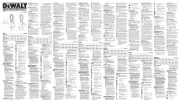
23 Mei 2025

18 Mei 2023

6 Mei 2023

5 Mei 2023

11 April 2023

6 April 2023

31 Maart 2023

8 Maart 2023

4 Maart 2023

27 Februari 2023
Handleiding Zaklamp
- EverActive
- Spanninga
- Silverline
- Silva Schneider
- Anker
- Maglite
- Olympia
- TFA
- Kayoba
- PNI
- Celestron
- HQ
- CEL-TEC
- Alpha
- Rocktrail
Nieuwste handleidingen voor Zaklamp
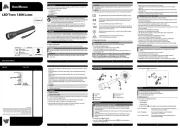
16 Juli 2025
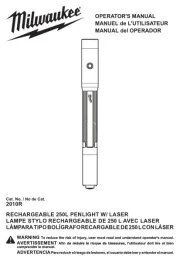
15 Juli 2025
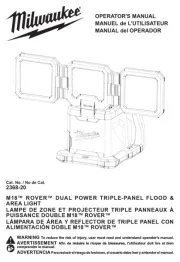
14 Juli 2025
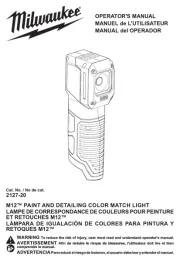
14 Juli 2025

14 Juli 2025
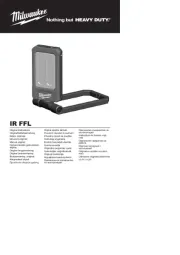
14 Juli 2025
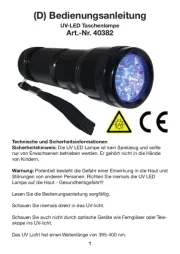
10 Juli 2025
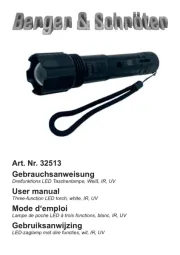
5 Juli 2025
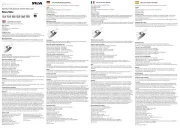
4 Juli 2025
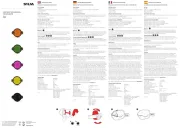
4 Juli 2025